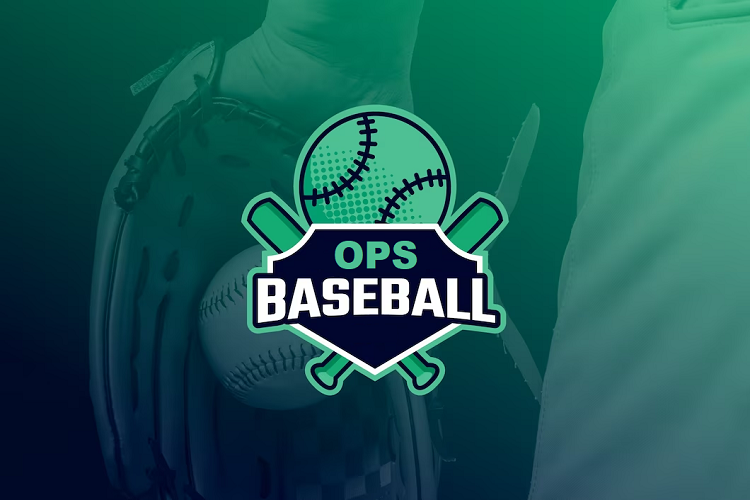OPS is a popular statistic among fans, analysts, and teams as it offers a quick way to gauge a player’s overall offensive impact. However, as the game continues to evolve and more advanced metrics are developed, it is often used in conjunction with other statistics to gain a more complete understanding of a player’s offensive abilities.

What is OPS in Baseball?
OPS stands for “On-Base Plus Slugging,” and it is a sabermetric statistic used to evaluate a baseball player’s overall offensive performance. It combines two key components of a player’s offensive contributions: their ability to get on base (represented by on-base percentage, or OBP) and their power hitting ability (represented by slugging percentage, or SLG).
The formula for calculating OPS is:
OPS = OBP + SLG
On-Base Percentage (OBP)
This is the ratio of times a player successfully reaches base (via hits, walks, or hit by pitches) to their total plate appearances. It reflects a player’s ability to get on base and create scoring opportunities for their team.
OBP is calculated as:
Slugging Percentage (SLG)
This measures a player’s power hitting by considering the total bases they accumulate from their hits (single, double, triple, home run) divided by their total at-bats. SLG gives more weight to extra-base hits, reflecting a player’s ability to hit for extra bases and drive in runs.
SLG is calculated as:

By combining OBP and SLG, it provides a comprehensive overview of a player’s offensive prowess, accounting for both their ability to get on base and their power hitting. Generally, a higher On-base Plus Slugging indicates a more effective offensive player, although it’s important to consider other factors like a player’s position, ballpark effects, and other contextual factors when evaluating their overall performance.
Why It Is Important to Consider When Evaluating Players
The OPS has become the go-to metric for measuring offensive productivity in modern baseball. It provides a more comprehensive method for teams to evaluate a player’s hitting abilities overall than either OBP or SLG by themselves.
- Combination of Key Offensive Skills: It combines two fundamental aspects of offense: getting on base and hitting for power. OBP reflects a player’s ability to reach base and contribute to scoring opportunities, while SLG accounts for a player’s capability to produce extra-base hits and drive in runs. By combining these components, it gives a more holistic view of a player’s offensive contributions.
- Simplicity: It is a relatively simple statistic to understand and calculate, making it accessible to a wide range of baseball fans, analysts, and even players themselves. Its simplicity allows for quick comparisons between players and teams.
- Weighted Approach: It gives equal weight to OBP and SLG. While other advanced metrics might provide different weightings for these components, OPS offers a balanced approach that treats both getting on base and hitting for power as equally valuable skills.
- Historical Context: It can be used to compare players from different eras, as it’s not as heavily influenced by external factors like ballpark dimensions, era-specific offensive levels, or changes in the game. This makes it easier to assess players across different time periods.
- Predictive Value: It has been shown to correlate well with a player’s ability to generate runs and contribute to team success. While it’s not a perfect predictor, players with higher OPS values often tend to perform better offensively and help their teams score more runs.
- Roster Decisions and Player Acquisitions: Teams often use OPS, among other metrics, to make decisions about player acquisitions, lineup construction, and player development. It helps teams identify players who can add offensive value and contribute positively to the team’s performance.
- Fantasy Baseball and Betting: In fantasy baseball leagues and betting, it is a popular statistic used to evaluate players’ potential contributions and project their performance.
While it is a valuable metric, it’s essential to consider other factors such as a player’s position, defensive abilities, baserunning, and the context of their offensive environment.
Players with the highest career OPS in baseball history
Here are some of the players with the highest career OPS in baseball history (minimum 3,000 plate appearances):
| Rank | Player | OPS |
| 1 | Babe Ruth | 1.1636 |
| 2 | Ted Williams | 1.1155 |
| 3 | Lou Gehrig | 1.0798 |
| 4 | Oscar Charleston | 1.0632 |
| 5 | Barry Bonds | 1.0512 |
| 6 | Jimmie Foxx | 1.0376 |
| 7 | Turkey Stearnes | 1.0340 |
| 8 | Mule Suttles | 1.0276 |
| 9 | Hank Greenberg | 1.0169 |
| 10 | Rogers Hornsby | 1.0103 |
Examination of Baseball during the Era of the OPS
Examining baseball during the era of the OPS provides insight into how this statistic has influenced the way players are evaluated and how the game is played. The increased use of advanced metrics like OPS has led to changes in player strategies, team management, and even contract negotiations. Here are some aspects to consider when examining baseball during the era of the OPS:
- Player Evaluation and Scouting: With the advent of On-base Plus Slugging and other advanced statistics, player evaluation has become more data-driven. Scouts and analysts now focus not only on traditional stats like batting average and home runs but also on OBP and SLG to assess a player’s overall offensive contributions. This shift has led to a more nuanced understanding of players’ strengths and weaknesses.
- Changing Hitting Approaches: Players may alter their hitting approaches to improve their OPS. Some hitters focus on increasing their walk rates to boost their OBP, while others emphasize hitting for power to raise their SLG. This can lead to changes in how hitters approach each plate appearance and how pitchers strategize against them.
- Lineup Construction: Managers often consider On-base Plus Slugging when constructing lineups. Players with high values are typically placed in prominent positions in the lineup to maximize their opportunities to contribute offensively. This strategic approach can influence the rhythm of the game and impact run production.
- Free-Agent Signings and Contracts: It has played a role in contract negotiations for players. Hitters with higher values are often perceived as more valuable and can command larger contracts in free agency. Teams are willing to invest in players who consistently contribute to a strong offensive performance.
- Fantasy Baseball Impact: It has become a significant statistic in fantasy baseball leagues. Fantasy managers use OPS to evaluate player performance and make decisions about drafting, trading, and lineup adjustments. This has changed the way fantasy leagues are managed and how players are valued.
- Player Development: Young players are now groomed to develop both on-base skills and power hitting abilities. Organizations prioritize player development strategies that help prospects improve their OPS, recognizing its importance in the modern game.
- Sabermetrics and Analytics Departments: MLB teams have established analytics departments to analyze player performance using advanced metrics like OPS. These departments guide decision-making related to player acquisitions, game strategy, and player development.
- Public Awareness: OPS has increased public awareness and understanding of advanced statistics in baseball. Fans and media now have access to a broader set of metrics to assess player performance beyond traditional statistics.
- Historical Comparisons: OPS allows for better historical comparisons of players across different eras. Fans and analysts can more accurately gauge the offensive impact of players from different time periods using a common metric.
- Influence on Rule Changes: The emphasis on OPS and offensive performance has led to discussions about potential rule changes to balance the game. Some changes, such as alterations to the baseball itself or adjustments to pitching rules, have been proposed to maintain a competitive balance between pitchers and hitters.
Overall, the era of OPS has ushered in a new era of baseball analysis and strategy. The use of this statistic, along with other advanced metrics, has contributed to a more comprehensive understanding of player performance and a deeper appreciation for the intricacies of the game.
Strategy for Playing the OPS Game
Playing the OPS game typically refers to strategizing in fantasy baseball or other fantasy sports leagues where OPS is used as a statistic to evaluate players’ performance. Here are some strategies you can consider when playing the OPS game:
- Draft Balanced Players: Look for players who have a history of both getting on base and hitting for power. These players tend to have higher OPS values. Balance is key, as focusing solely on power hitters or on-base specialists might limit your team’s overall offensive performance.
- Positional Scarcity: Consider the scarcity of high-OPS players at different positions. In some positions, finding players with strong OPS might be rarer, so prioritize those positions during your draft.
- Ballpark Effects: Research how a player’s home ballpark affects their OPS. Some ballparks are more hitter-friendly, which could boost a player’s power numbers and overall OPS.
- Consistency Matters: While some players might have occasional bursts of high performance, aim for players with a consistent track record of maintaining a strong OPS over multiple seasons. Avoid players with volatile performance unless they offer other valuable contributions.
- Plate Discipline: Players with a good eye at the plate tend to have higher OBP, contributing to a higher OPS. Look for players with a history of drawing walks and having low strikeout rates.
- On-Base Specialists: Don’t underestimate the value of players who excel in on-base skills, even if they don’t have high slugging percentages. These players can still contribute significantly to your team’s OPS by getting on base and scoring runs.
- Young Talent: Identify young players with the potential to improve their OPS as they gain experience and develop their skills. Investing in emerging talent can provide a competitive advantage in the long run.
- Injury Risk: Be cautious with players who have a history of injuries, as they might miss significant playing time, impacting their ability to contribute to your team’s OPS.
- Trade Opportunities: Throughout the season, monitor player performances and trade opportunities. You might be able to acquire players with potential to boost your team’s OPS if their current owners undervalue them.
- Flexibility: While OPS is important, remain flexible in your strategy. Depending on your league’s rules and scoring system, you might need to adapt your approach to account for other statistics as well.
Remember that while OPS is a valuable metric, it’s just one piece of the puzzle. Consider other factors such as position scarcity, team needs, injuries, and the overall fantasy point system used in your league. Successful fantasy management involves a combination of strategy, research, and timely decision-making.
FAQs
What does a high OPS indicate?
A high OPS generally indicates a player who is effective at both getting on base and hitting for power. It’s a good measure of an overall offensive threat.
Is OPS adjusted for park factors?
In some cases, yes. OPS+ (OPS Plus) is a version of OPS that adjusts for the league and ballpark factors. An OPS+ of 100 is considered league average, and values above 100 indicate an above-average offensive performance.
How is OPS used in fantasy baseball?
OPS is used to evaluate players’ offensive contributions in fantasy baseball. Players with higher OPS values are often sought after because they provide a combination of getting on base and hitting for power.
What are the limitations of OPS?
While OPS is a valuable statistic, it doesn’t provide a complete picture of a player’s offensive abilities. It doesn’t account for differences in batting average, the importance of specific situations (e.g., game context), or baserunning abilities.
Who are some players with historically high OPS values?
Players like Babe Ruth, Ted Williams, and Barry Bonds are known for their exceptional OPS values. However, the list of players with high OPS values changes over time due to new players entering the league and evolving offensive strategies.
Are there other advanced stats similar to OPS?
Yes, there are. Some similar statistics include wOBA (Weighted On-Base Average) and wRC+ (Weighted Runs Created Plus), which provide a more nuanced assessment of offensive performance by accounting for the value of each offensive event and adjusting for various factors.



